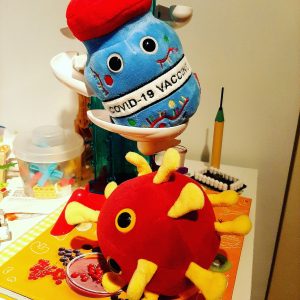
The Food Service Safety edition: December 2021
ANNOUNCEMENTS
Monthly Subscriber Prize Drawing
December winners will be drawn and contacted via email very soon! To claim your prize, you must respond within one week of receiving confirmation, so keep an eye out!
SAVE THE DATE
The 2022 Statewide Conference on Occupational Safety & Health will be held April 1, 2022 – April 3, 2022 in Saratoga Springs!
Follow us on social media!
Facebook:@CSEASafetyNet Instagram: @CSEA_safety_net
New! Seeking Spotlight Submissions
Share your story, meme, or photo for chance to be featured in the Safety Net Newsletter!
All participants will automatically receive a prize for submitting their content relating to workplace safety & health. Submissions can be emailed to Bernadette Foley at Bernadette.foley@cseainc.org, or sent via Facebook @CSEASafetyNet or Instagram @CSEA_safety_net.
Spotlight
Thank you, Kari, for submitting to this month’s Spotlight!
“These are Giant Microbes, and my 11-year-old son with Autism has been collecting them since he was 4!”
“THE OWNERS OF ZOOM CALLED AND WANT THE COVID-19 VACCINE BACK!”

Safety & Health News Highlights
Vaccine Mandate Rejected by Senate
On Wednesday, December 8, the Senate voted to block President Joe Biden’s vaccination-or-test mandate for private sector workers of business with 100 + employees.
Temporary Mask Mandate imposed by Governor
NY Governor Kathy Hochul has instituted an indoor mask mandate for staff and patrons from now through at least January 15 for all workplaces that do not have a requirement to show proof of vaccination.
Worldwide Food Safety Month
‘Tis the season for holiday gatherings and home cooking, so what better time to brush up on food safety! Whether you have experience or are currently working in the food service industry, reviewing best practices is key to keeping everyone safe and healthy this holiday season.
In observance of this month’s topic, we would also like to acknowledge to our hard-working members in the food service industry. This includes those working in school districts, hospitals, nursing homes, group homes, colleges/universities, and correctional facilities. We also want to recognize those who work for municipalities in food sanitation, making sure food service establishments are complying with health and safety practices to keep all of us safe.
FOOD SAFETY: BEST PRACTICES FOR HOME COOKING
Following proper guidelines during the cooking process and hygiene practiced before, during, and after the preparation of a meal is essential in avoiding foodborne illness.
A useful guide for temperatures and cook times when cooking meat and poultry:
https://www.foodsafety.gov/food-safety-charts/meat-poultry-charts
4 Basic Steps to Food Safety at Home:
DID YOU KNOW?
ACCORDING TO THE CDC, EACH YEAR APPROXIMATELY 48 MILLION PEOPLE GET SICK FROM A FOODBORNE ILLNESS, 128,000 ARE HOSPITALIZED, and 3,000 DIE.
KNOWLEDGE IS POWER
FOOD SERVICE INDUSTRY WORKERS
Safety and Health Hazards
Food service safety and health goes beyond the preparation and storage of food. Industrial kitchens have numerous hazards that often get overlooked and when not managed correctly, can cause serious injury, illness, or death. Educating yourself and others of the risks and reporting unsafe conditions can greatly reduce workplace accidents.
Kitchen Injuries: Tips to Avoid a Spill, Slip, or Hospital Trip
Injuries are common in industrial kitchens. Often the work is physically demanding and conducted under pressure. Moreover, workers who engage with the public are at higher risk for violence or harassment.
- Cuts: cutting, slicing, dicing, boning meat
- Burn hazards: hot oils, pans, trays, direct flame
- Injury from machines: operating while impaired, inadequate space, loose clothing, falls
- Slips, trips, and falls: slippery or otherwise compromised floor surfaces, walkway obstructions
- Lifting injuries: pushing, pulling, bending; muscle strain/musculoskeletal damage can occur
- Head + eye injuries: reaching for items on overhanging shelves or in tight, confined spaces
- Crowded workplace: increases risks of slips, trips, falls, spills, and other injuries
- Chemical exposure: misuse while cleaning and sanitizing, improper storage
- Fire hazards: accidental ignition of flammable fuels, liquids, and gases
- Electric shock: high number of appliances in use; faulty wiring; improper care/use; exposure to liquids, moisture, or heat
Download a free printable kitchen safety poster
NO SAFETY, KNOW PAIN
Actions You Can Take
If you suspect a hazard or get injured on the job, reporting and record keeping is imperative. All injuries should be reported to your employer and your union representative no matter how seemingly insignificant they may appear. If multiple incidents occur from the same hazard and go undocumented, they technically don’t exist. When such incidents are reported, your union can take action to address the issue. Providing documentation helps leadership and OSH Specialists build leverage when negotiating or bargaining for workplace improvements. This is also essential when filing a PESH or OSHA complaint.
MEMBER RESOURCES
How can CSEA Help?
For additional information on reporting safety concerns to CSEA and to access our online accident/incident form, visit https://cseany.org/safety-report
To learn more about topics related to food service industry hazards, check out our fact sheets:
- Fire Prevention
- Fall Prevention
- Electrical
- Chemicals In Home
- Reporting & Recordkeeping
- Shiftwork
- Workplace Stress
For more member resources and materials, visit our member resources page.
CSEA Occupational Safety + Health Specialists can provide training, technical assistance, labor-management services, and even help establish a Safety and Health Committee in your workplace.
Contact your OSH Specialist here

